The wooden door relatively quickly loses its aesthetic appeal. But if it happened, it is, of course, not a reason to acquire a new door. He helps out the color, which is not as complicated so that the amateur does not cope with it, but not so primitive to refuse to get acquainted with the tips on painting.
Process Features: Painting Wooden Doors
On any building today there are a lot of painting materials that can be used. Formulations are different in price, quality, features of application and result. It is important what you are inclined more: whether you want to emphasize the natural texture of a tree, or you wish to hide under the layer of paint texture pattern.
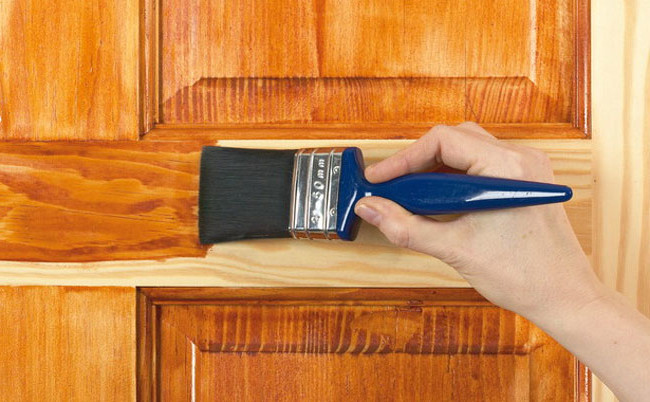
In any case, choose usually from the following compositions:
- Opaque enamels, as well as painting compositions on alkyd, acrylic, polyurethane, perchlorvinyl basis. Also here can include oil-based compositions that are no longer so relevant.
- Transparent varnishes, toned varnishes, oil impregnations, simulats, which refresh the color of wood, or give the new shades.
Specialists advise at home to use acrylic dyes on a water basis, because it is easy to work with them. They have good consistency, excellent spreadability and good shelterness. Alkid-based products can also be purchased. She has high water repellent properties, it is characterized by a good resistance to temperature surges and drying speed.
Step-by-step process: how to paint the door from the tree with your own hands
First, it is necessary to remove the door leaf from the loops, after which it needs to be put on two stable torerere or desktop. If you decide to use an alkyd composition, then it is recommended to work on the street. Well, or at least on the balcony.

If you do not want to remove the cloth, it is necessary so to block the wedges so that the Pilenseed brush can achieve all the door items. In addition, blocking will help that the door does not close, damaging the dye layer.
Preparation of doors to painting:
- Remove all old paint layers, as well as previous primers and putty from wood. You can use both an ordinary grinding machine and bar with a glued sandpaper of medium grain. There are on sale and special washes for wood, allowing you to remove the old paint.
- Then there is a primary grinding - minor dents are eliminated, the remains of old paint, scratches, chips. You can do it and sandpaper.
- Then there is a putty of large defects. For this, a special putty for wood is purchased. This is done if the door you plan to cover with varnish, mourn or butter. It is necessary not to forget about the slots between the decorative parts of the canvas and the door web itself, as well as between the Podolok and the jam.
- After complete drying, the putty is the second layer of grinding sandpaper. You can use an abrasive skirt with an average grain size.
If there are deep dents on the wood, and the painting will not be transparent, they can be embedded by auto-suck. Only in this putty should not be fiberglass. Such a stage as preparation is obligatory, without it, the door repainting the apartment in an apartment or house cannot be qualitative.
Sequence of work: Painting interroom doors
Small details, as well as corners score with a brush. The largest square is easier to process the roller. The primer layer of paint is always polished by paper. And decorative paint is applied along the soil.
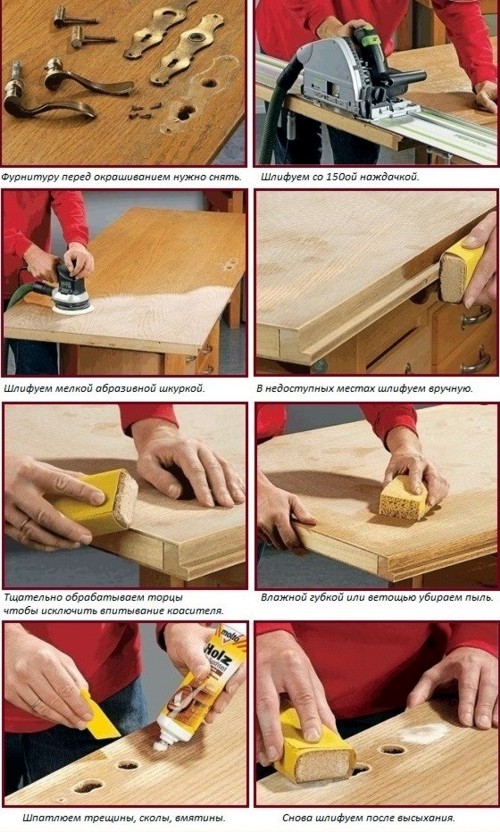
You need to paint in two stages. The first dying paint plays the role of soil. And this primer is desirable, two tones should be brighter main paint. So exactly the primer will not affect the final color of the door.
Much depends on the type of door:
- Themarket doors are always beginning to paint with a brush. Tassel walk through the recesses in the canvas, but just do not allow the paint rebuilding. And the staining of the roller is completed.
- The shield door is painted in three receptions. The roller in this case is considered a more practical tool. Covering the paint door should be started from the end, namely from the upper left corner of the door canvase. So paint everything canvas, and dry it for several hours. The second stage is staining in the longitudinal direction, the third is already in the opposite stage No. 1.
This specification we are talking about standard staining. If you, for example, want to repaint the door to white. But there is painting with various effects - Under the old days, with scuffs, etc.
Application of veil: how to paint a wooden door
If a simulator is used, prepared in advance to the color of the door need to be slightly moistened so that the wood does not absorb moisture. Then even a liquid dye falls smoothly. Kosyaki, as well as a canvas not removed from the loops, start covering precisely below, then the splashes of the dye will not fall into unpainted areas. But if the finish makeup will not be transparent, then dark drops will not interfere.
![]()
When a water-soluble vehicle is covered with a tree, wood fibers, which absorbed moisture will disappear. They need to be pulled out with a neckline, when the first layer is dry. Then the surface is cleared of dust, and there is a second layer of the veil.
In order to achieve compatibility of color, you need to repeatedly cover the surface. Only this will give the desired effect, otherwise the door will be lighter than during staining.
You can repaint the door from the Fiberboard, and the door from the MDF, and the veneered door, and laminated. Sometimes you have to paint and a completely new door from the veneer, then the preparatory process will be easier. As for the color, the dark today is not so relevant, like white, gently pistachio, soft sand, etc.
How to paint interior doors (video)
Restoration of the door - the process is not so fast, if you do everything according to the rules. Primer, putty, applying decorative coating is not so soon, as you want. But only such a sequence will lead to an ideal result.
Fruit work!
Thanks to staining, the new door in an apartment or house can become not only more aesthetically attractive, but also in more thanProtected from the influence of environmental factors. The same applies to the old doors, because over time, any painted surface loses its former attractiveness, since the paint fills, peeling and bubbles. Painting of wooden doors - enough simple workHowever, there are nuances in this case, without understanding which it is difficult to achieve a good result.
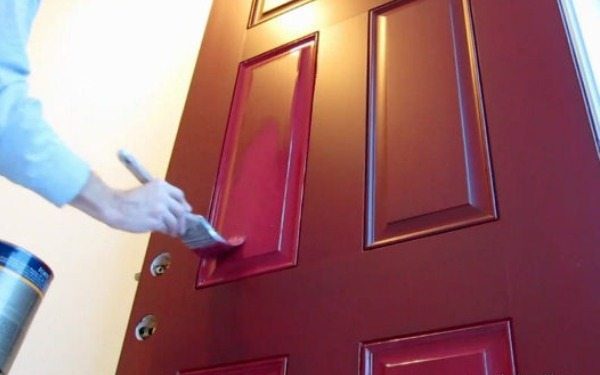
Selection of paint
Coloring due to the enormous variety of compositions allows wooden product to give a wooden product. Paints are transparent, matte and glossy. Moreover, if there is a desire, it is possible to use several types of paint for one door - it all depends on the tasks set, the wishes of the master or designer. Very often, the doors are first impregnated with a tinting composition, and then decorative coating is applied.
Note! Not all paints and varnishes are compatible with each other. For example, a grinding is suitable for lacquer, but not Olifa.
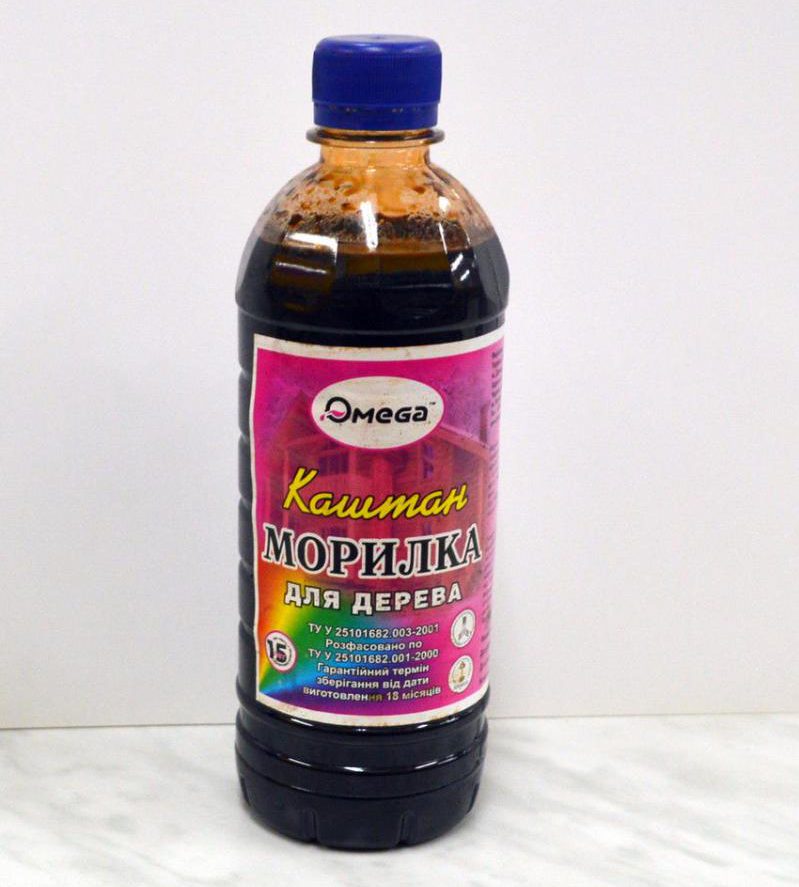
Door paints are made on the basis of acrylic, polyurethane, alkids, perchlorvinyl. Very rare and outdated option - oil-based paints. Today, even domestic producers refuse them.
For staining doors, it is recommended to use acrylic or alkyd paint. In acrylic latex formulations, a suitable consistency for work with a tassel, as well as decent spreadability and holing (although acrylic paints and varnish compositions are inferior to oily). Alkyd paints are characterized by excellent water repellent properties, and in addition, they are distinguished by high resistance to temperature differences, as well as rapid drying.
Note! Alkid painting compositions can be applied only on perfectly dry wood. If the surface is wet, its adhesive qualities will not be enough to ensure reliable grip with paintwork material, the result of which will be paint exfoliation.
Paints have two competitor - varnishes and impregnations. To understand the differences between these compositions, we will briefly focus on their properties and tasks:
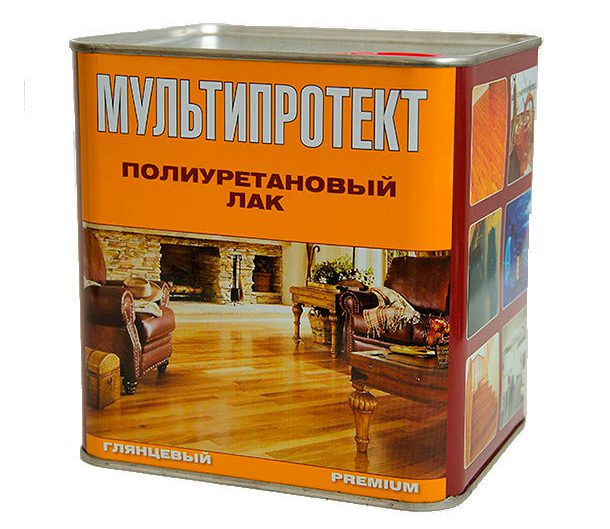
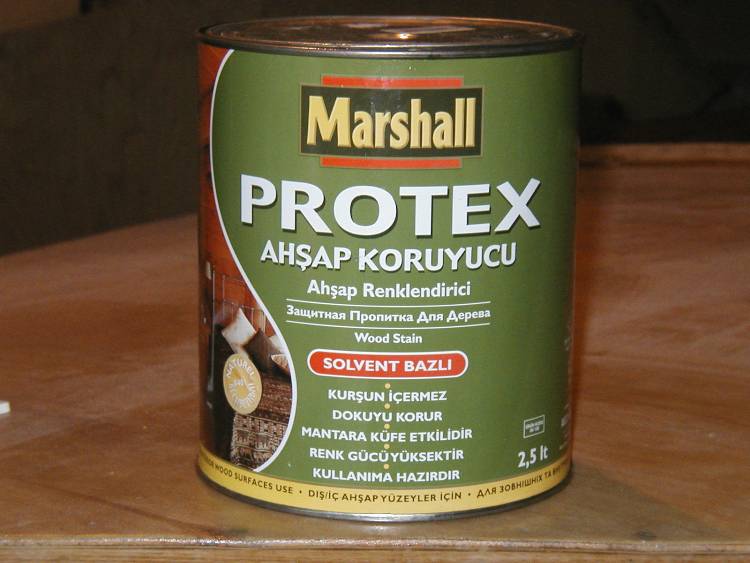
Staining technology
Painting of wooden doors with their own hands begins with the removal of the design with the loops. After the door is dismantled, put it on a flat surface (you can use a table, a pair of stools, etc.).
Note! If an alkyd paint is used, all work is recommended on the street or indoors where there is a large air volume.
Next, block the canvas in such a way as to have free access to the tassel to all the necessary items. Lock is needed in order to prevent accidental closing of doors during the drying period. If the door closes, damage to the paint layer is possible.
Accessories is also desirable to remove. If it is impossible, as well as in the case of non-removable loops, all the details need to be protected from paint. For this, the paper is suitable, which can be attached by scotch. It is even better to wind the fittings of the foil. Castle mechanisms are recommended to take scotch.
Preparation of wooden surface
To prepare wooden doors to paint, they must be pre-cleared, and then process the primer and putty.
Below is presented step-by-step instruction on the preparation of a wooden surface:
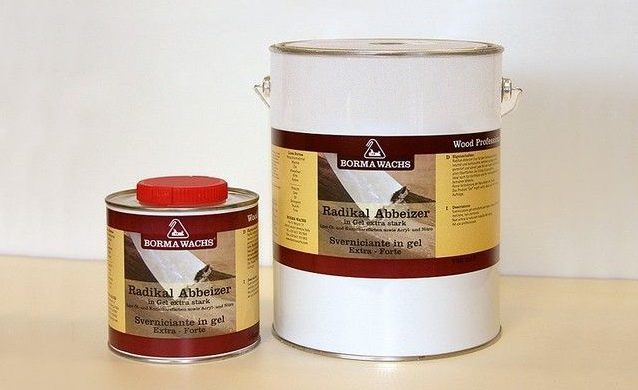
Tip number 1. Too noticeable dents can be leveled by the automotive putty. The choice of this material is dictated by the absence of fiberglass in its composition.
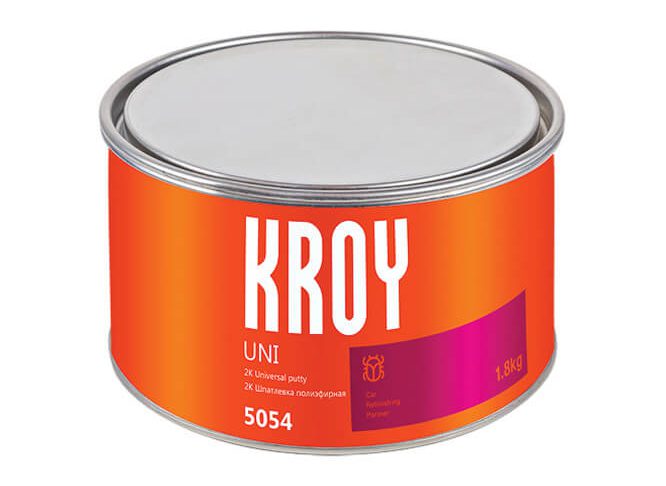
Tip number 2. If wood under old paint has become too dark, it can be lit. To do this, process the surface with water chlorkin solution. The ratio of components in the solution is 1 to 3.
Upon completion of grinding, we clean the surface from dust using a vacuum cleaner, and then wipe the wooden product with a damp cloth.
Coloring in the usual way
In this part of the article, we will not stop on the wise ways of staining, for example, artificial formation of the surface, painting or underlined by special methods of wood texture. It will be about the usual staining of the doors. It is necessary to make it high quality - so that the surfaces are not left and stains on the surface.
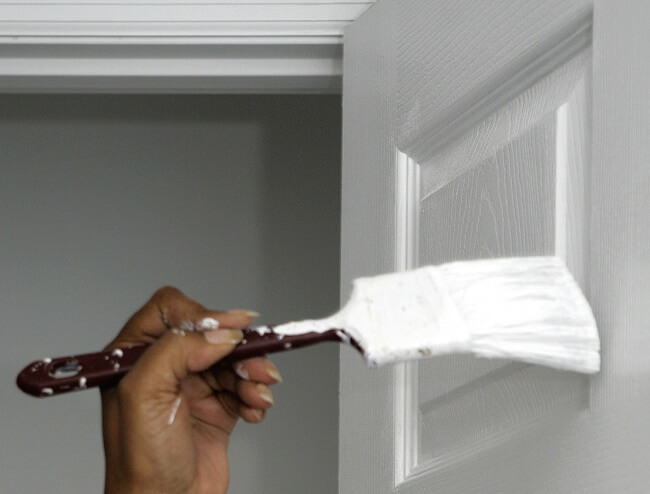
For staining one or two doors, buying a sprayer is unlikely to make sense. Therefore, it is possible to use a narrow viper brush for the violent web, and a roller will fit all types for the webs.
Further actions depend on the design features of the door:
- The panel door is painted in three stages. When staining, we use roller, as it allows you to apply paint more evenly and leaves hairs. First of all we apply paint on the end. From the upper left corner of the end moving to the right. Thus, stain all the cloth, and then dried it in accordance with the instructions from the manufacturer's company. At the second stage there is a door longitudinally. Finally, we do the same as at the first stage, but from the right corner.
- When painting the panel door, we use a brush. Carefully process the surface, not forgetting about deepening. This should avoid excess paintwork on the canvas. After the paint layer will dry up, we do the same as indicated in the instructions for staining the panel door.
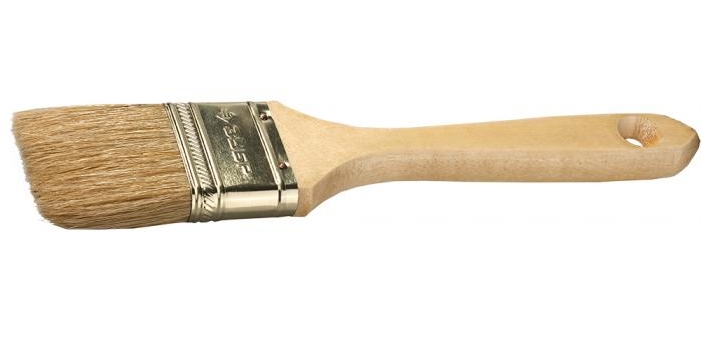
Work with Morilka
Clean door slightly moisturize. On the wet surface, the simulation will be lying better. Prayes at the beginning along the fibers, then - across. The third layer is again applied in the direction of fibers.
Shines and canvas (it does not need to be removed) processing from the bottom so that the drops do not fall on the clean surface. This concerns staining with transparent compositions. If we are talking about opaque paint, the direction of staining does not have the value.

After applying the veils based on water, the fibers are slightly raised. Therefore, it is necessary to grind with the help of zero skins. Then we remove the dust and apply another layer of the veil. Alcohol Morilka does not provoke raising fibers. Based on this, it is not necessary to grind the surface after such a verse. The advantage of water compositions is non-toxicity and.
Note! Not yet a dried surface, it seems darker than it will be when he dried. Darker tone is achieved by re-staining.
Wood imitation
On how to paint the door under the tree, briefly described below:
- We apply to any material (for example, on MDF) yellow, light gray or light beige paint. We wait until the surface is driving.
- We process the surface with liquid soap.
- We apply a layer of dark paint and wash off the liquid soap.
Veneered doors can also be given a full-fledged wood texture. For those who want to learn how to paint the door under the tree, this option is offered:
- Special brush-comb processing soft veneer fibers. A semblance of wood texture will appear on the surface.
- We apply one or more layers of paint.
- Grind the surface.
If you adhere to elementary rulesWhat is told in the article, there should be no difficulty when painting the door. For beginners, it is recommended to start painting the canvas with an inside or stretch on a piece of unnecessary wood. It is so easier to fill your hand and avoid mistakes in the future.
Sections Articles:
Thanks to modern innovative materials, you can give old wooden doors A completely new kind, appropriate fashion trends. It is not difficult to do it yourself at home. The main thing is to comply with technology. In the article we will tell about how to paint the wooden door and what materials with the tools will be needed for this.
Before coloring
When the door is still new and not exposed to staining, it is necessary to decide whether to leave the natural beauty of natural wood visible or coat it with a solid opaque layer of paint. What exactly to paint the wooden door - the choice of materials for work will depend on this solution.
Selection of paint
If it is decided to preserve the natural color of the wood - there is no need to buy paint. In this case, the oil impregnation or transparent varnish will be needed. They are well refreshing the color of wood. Give the array new color shades will help tinted lacquer or veil.

If you want to update the already existing lacquered surface, you need to purchase a putty under the color of the array. It is useful for aligning the surface of the door leaf after removing the old varnish.
For opaque painting of wooden surfaces There are many enamel options: alkyd, oily, polyurethane, acrylic, perchlorvinyl. For painting bath doors It is better to choose polyurethane paint: it has high resistance to negative external influences.
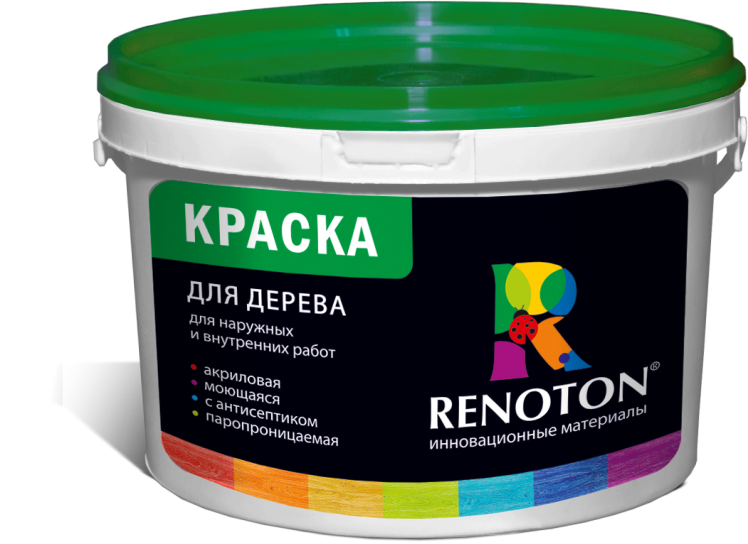
Better to paint interior wooden doors? Unprofessional masters experts recommend choosing acrylic water-based paints. They have an optimal consistency for working with a brush and spread well. These paints have high water repellent qualities, good drying speed and resistance to temperature fluctuations.
Selection of tools
For painting, a narrow fillet brush and roller will be required. A brush is scorched by a fillet canvas and all sorts of decorative rails on the door. The roller is useful for staining of large and smooth surfaces of the door leaf. You can purchase a paint sprayer, but it is advisable to have a certain experience to work with it. In addition, for staining one or two doors to acquire this tool is unprofitable.
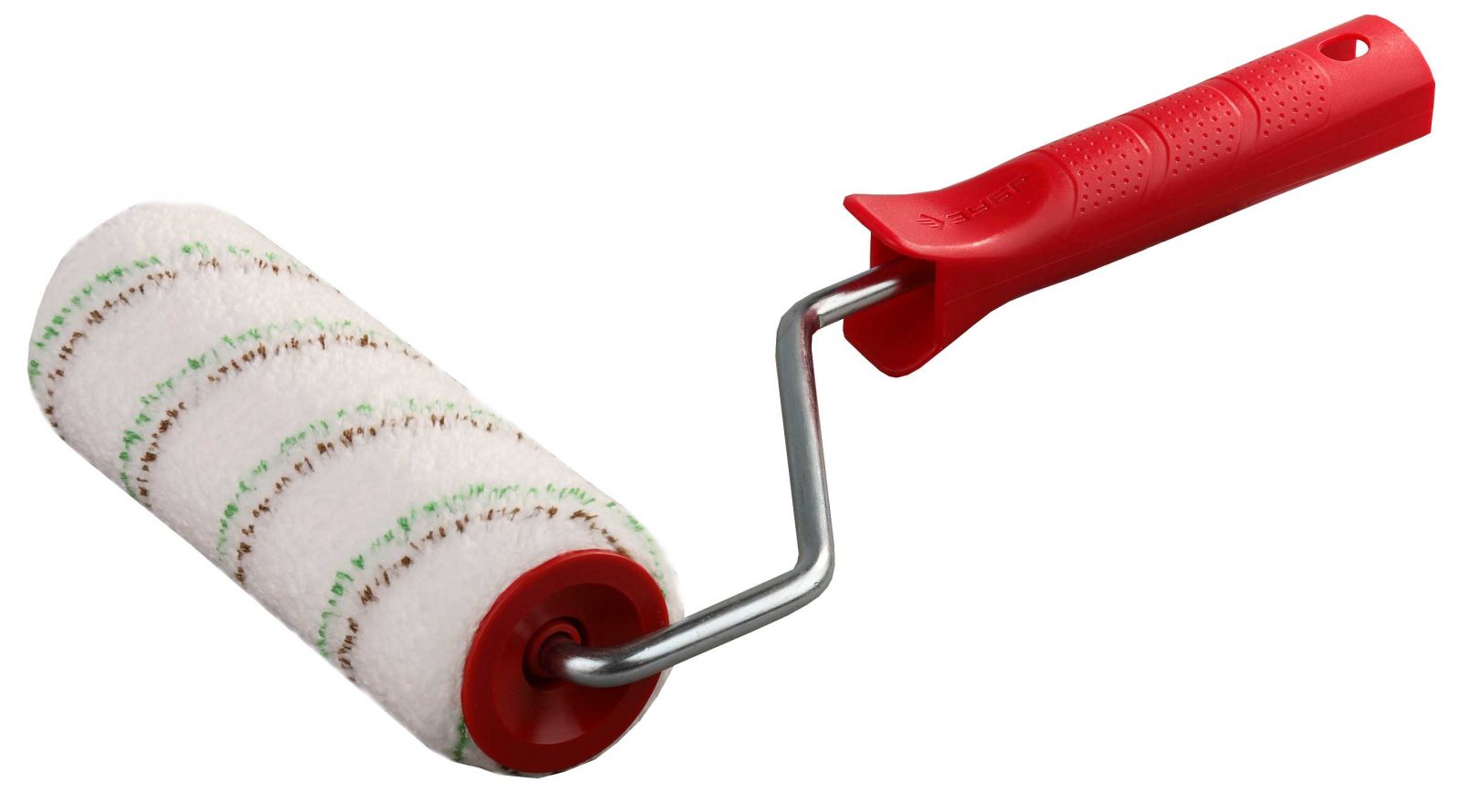
Coloring
Those who saw the Wooden Master doors paint, it may seem that there is absolutely nothing complicated. However, a newcomer to achieve a good result, it is necessary to strictly follow all instructions and the procedure for performing work.
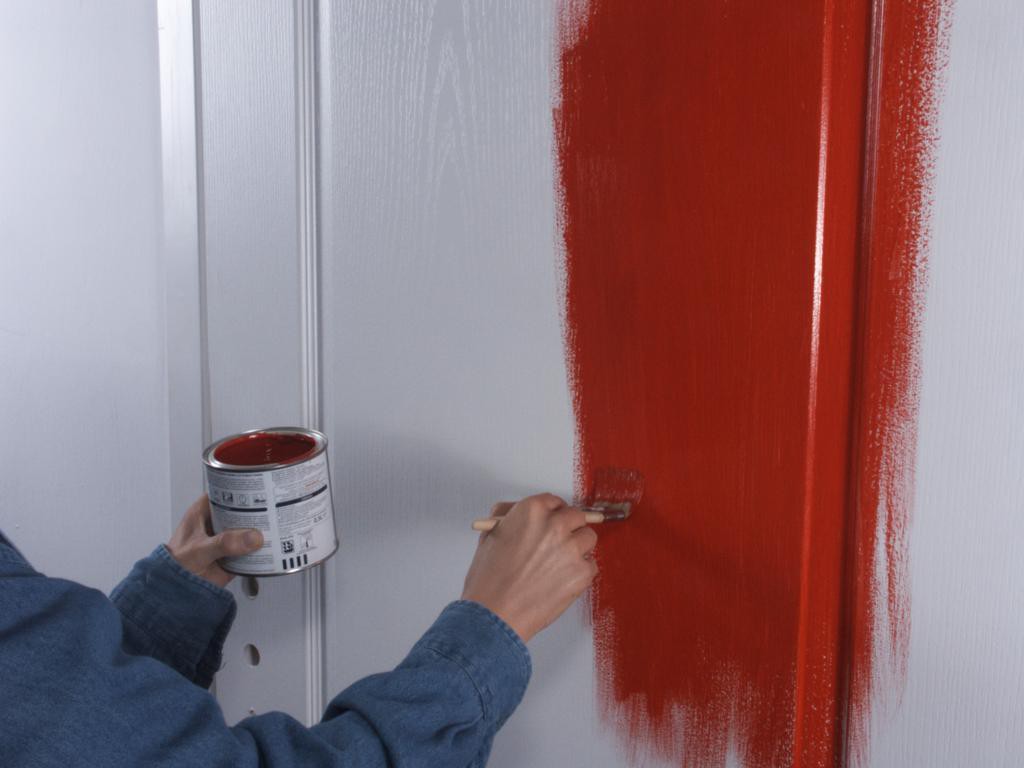
It is important to learn how to paint the doors evenly, without the formation of frozen herones or spots under varnish.
Often painting is produced in several stages. First use impregnation, it happens with a toning effect or without it. After that, the decorative coating is applied.
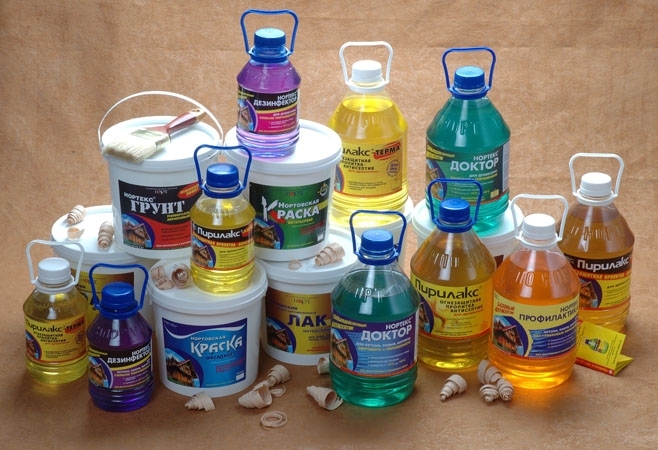
How to paint a wooden door without applying paints and varnishes? In this case, the impregnation or the versicle must be applied at least three layers in order to maximize the surface from external influences. A larger number of layers are applied to achieve the desired color shade.
Do not forget that shoals with Poktivok also need to be updated. Preparation for their staining is performed in the same sequence and the same tools as for the door canvase. Because to dismantle and endure before painting door box It makes no sense to the street, it is important to take care of protection outdoor coating From the ingress, as well as provide in the room with fresh air access for high-quality ventilation.
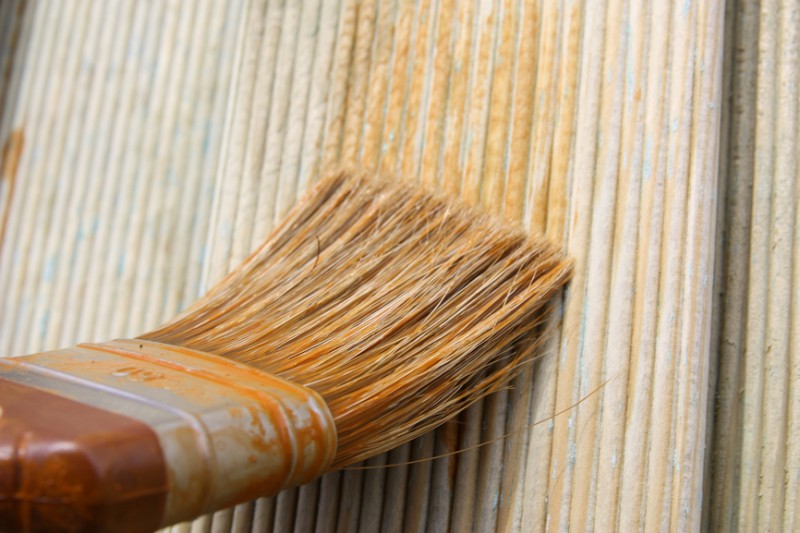
The tool applied to the surface may be incompatible. For example, the door covered with varnish cannot be soaked with oil. In this case, only the veil is suitable. It is also important to remember that all dyes based on alkyd resin can be applied only on a dry surface, otherwise the paint will be peeling.
Preparation of door leaf
To paint the door as high qualityly as possible, it is removed from the loops and put into the horizontal position on the "goats", two stools or desktops. Place the removed door is best in the fresh air. So it will dry faster and in the residential room will smell the paint less.
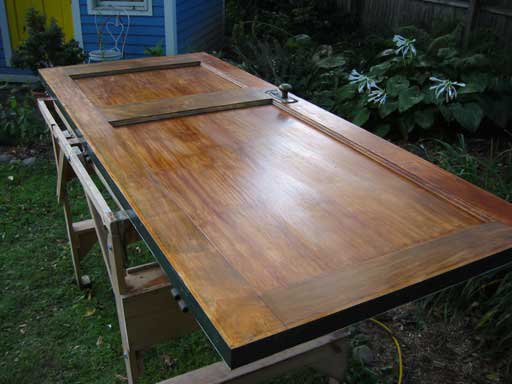
If you remove the door for some reason it is impossible, you need to block the canvas with wedges so that the fillet brush can easily get to all the necessary door items. This is also necessary for the door to accidentally closed until complete drying.
It is advisable to dismantle and fittings. If this is not possible - close the handles and hinges with a metal foil. The locking mechanism is fixed in the "open" position and shut a scotch.
Cleaning the surface
For those who are not a professional professional, one of the most important issues will be how to remove the old paint from the wooden door? The question is really important, because the quality of this process will largely depend on the final result. Therefore, special attention should be paid to the preparation of the door to staining.
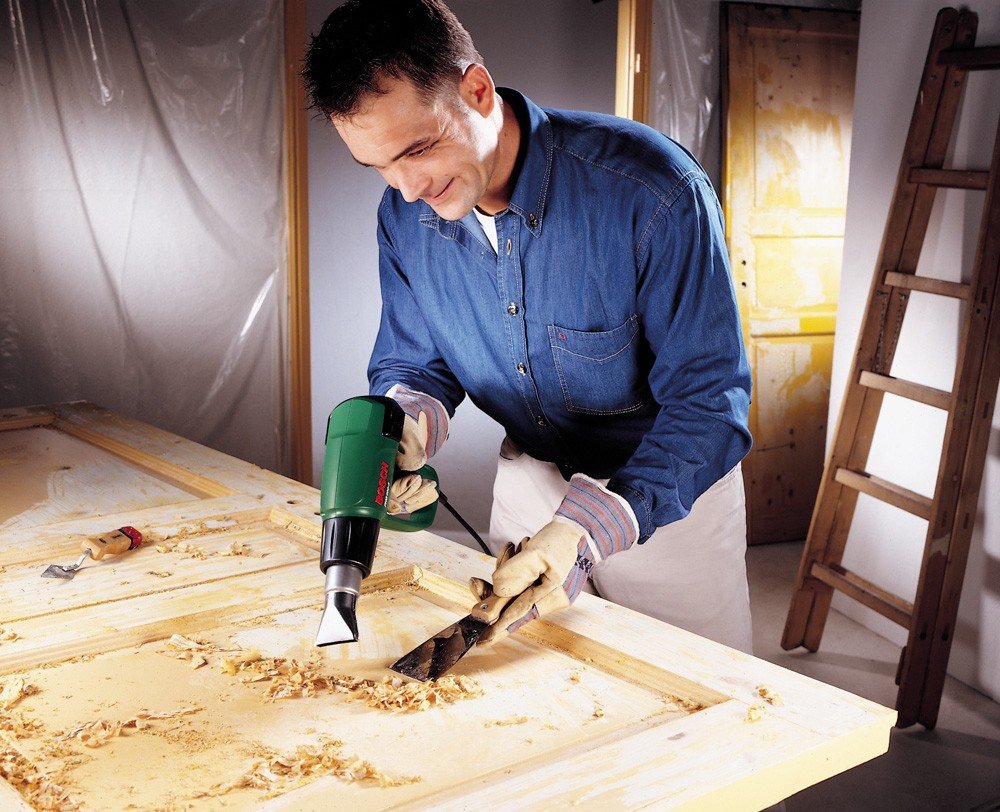
Before the new painting, it is necessary to remove all the old layers of paint, primer and putty to the wood itself from the surface of the door. Such work is easy enough to perform a grinding machine. A more time-consuming method - the use of a self-made device consisting of a bar convenient for the hand shape and glued to the working surface of the medium-sized sandpaper. The most effective is the use of a constructional hair dryer. It warms the paint, after which it is easy to remove the spatula. Another way is to wash away the old paint with special means. It is not complicated, but costly - such funds are notable.
Grinding
After that, they produce an initial grinding that eliminates small dents, scratches and paint residues. Here you can also use a grinding machine or medium waste paper.

Next, the surface is aligned with a spheolder: large dents, cracks, cracks, etc. are embarrassed. Deep dents can be lifted with auto ship, which does not include fiberglass. It is important not to forget that the clear coating is selected to the tone of the natural woodcase.
After complete grazing, secondary grinding is performed. First, abrasive is used as in the previous stage, then the fine-grained analogue. The processed surface is required to spend pressure, wipe with a damp cloth and dry well.
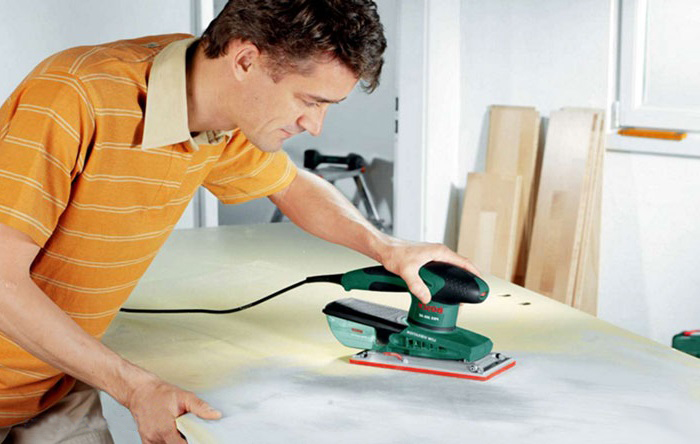
Sometimes after removing the old paint, it is found that the woody array looks quite good and can not be applied to it an opaque covering. In this case, it is recommended to bleach it with a mixture of a chlorine bleach and water in proportion of 1: 3, dry well, and then cover with varnish.
Coloring
To understand how to put one or another wooden door correctly, it is important to figure it out in its device. The most common types of doors under painting are shield (completely smooth) and Filöncata (with deepening and, possibly, slats). The shield door is correct to paint in three receptions. It is better to use a roller, it ensures uniformity of application and leaves no hairs.
Painting techniques
You need to start from the upper left corner of the door leaf and go to the right side. Such a direction to adhere to the end of staining, then dry in accordance with the instructions on the paint. Staining for the second time is made in the longitudinal direction. The last staining begins on the right upper angle, opposite to the first stage of painting.
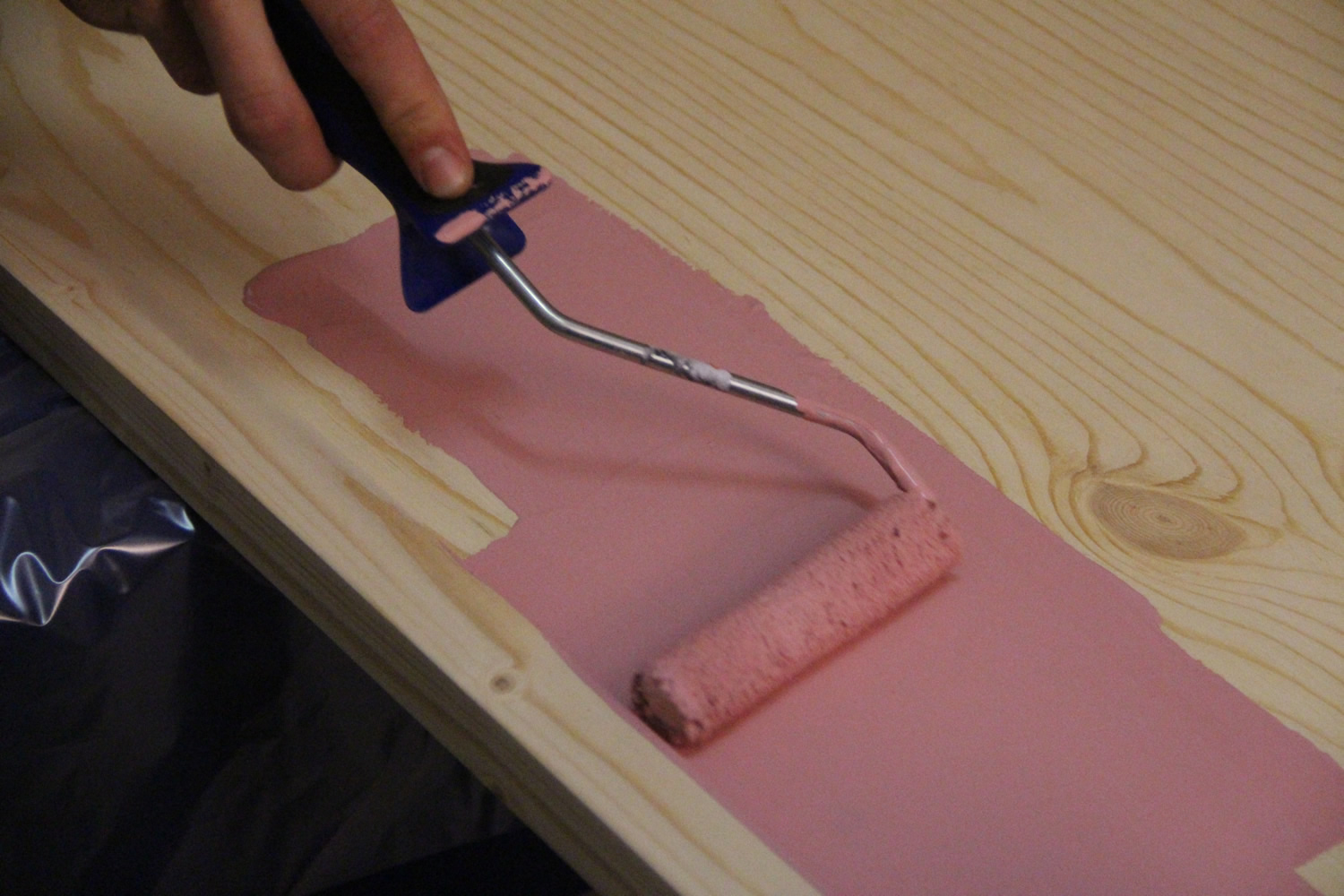
Filönchatu door is beginning to paint with a brush. Before starting work, the brush must be fluffy for all the poorly fixed hairs fell out, not falling into the paint. It cries all the recesses in the canvas. It is important to follow, so that there is no paint rebuilding. After that, the roller enters the work and the staining is performed in accordance with the above process stages for the board door.
Staining Morilka
What else can you paint the interroom wooden door? If you dye a verse, then the door prepared for painting needs to be pre-slightly moistened. In this case, a dye having a liquid consistency will fall smoothly.
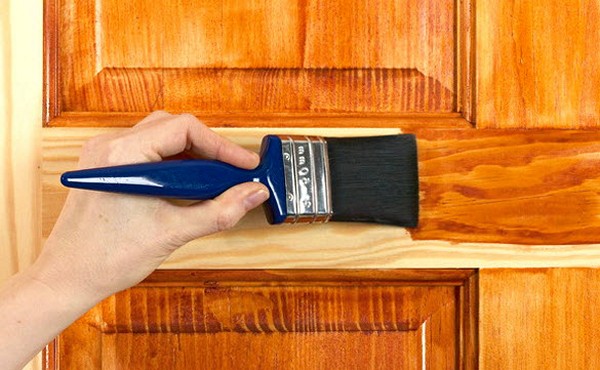
The first applying of the veil is produced along the fibers, the second - in the transverse direction, the third is similar to the first. If the canvas is not removed from the loops to start painting, you need to bottom so that the dye drops do not fall into unpainted areas, otherwise it will be difficult to achieve a smooth tone. The same goes and the door box. This is relevant to prepare the surface under varnish or other transparent coating. If the doors will eventually be covered with an opaque composition, random droplets of the simulators will not damage the final appearance of the doors.
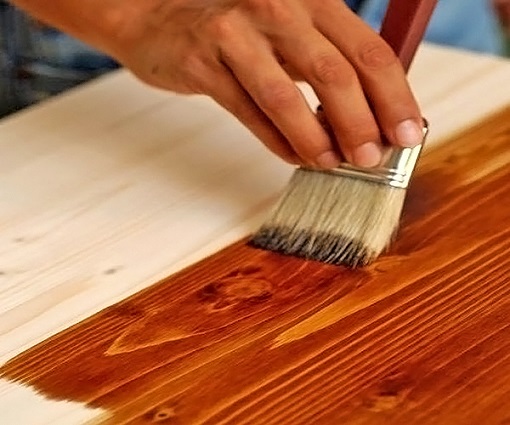
Water-soluble veil allows you to have absorbed moisture fibers to straighten. In order for the surface of the doors to remain smooth, after drying the first door layer, they grind the skin-zero, then purified from dust and covered the versus the second time. A wooden surface during applying a dye for several tones is darker than dried. This must be considered if there is a desire to achieve a specific color shade.
The alcohol veil does not stimulate the straightening of the fibers, so it is not necessary to grind the doors after applying it. Such a veil dries very quickly, but water-soluble is considered more secure.
Wood imitation
If you wish, you can imitate MDF or upholstered plywood doors under natural wood. There are several ways of such a decor.
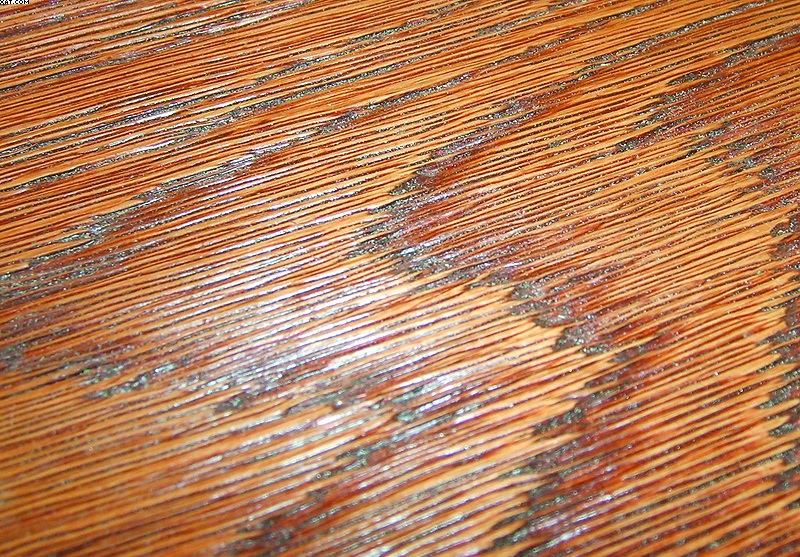
Option first
The door leaf is painted with light gray, light beige or yellow paint and is left to complete drying according to the instructions of the painting maker. A wide brush, the entire door surface is processed with liquid soap. A layer of more dark paint is applied, and a liquid soap is fluttering on the surface.
Option two
It will take a special brush for its implementation, which can be purchased at any construction store. This brush is handled soft fiber coating doors. Then the surface is painted two different colors (under the tree) dyes. Changes in the structure of the canvas produced by the brush will spontaneously give curls creating the illusion of wood.
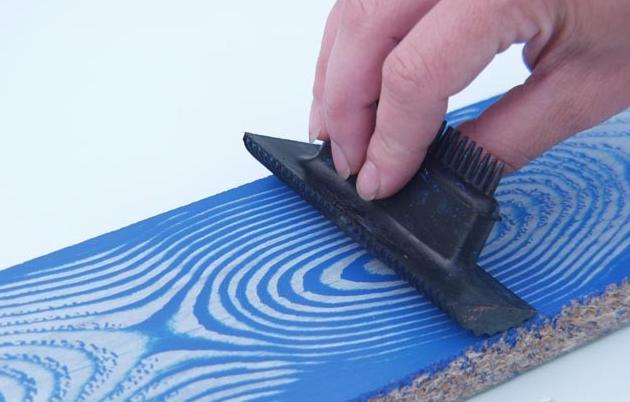
After complete drying, the surface is grinning and varnished. Similar method can be renovated and furniture.
The execution of such a work will not be too simple, therefore it is recommended to pre-train on a different similar surface, and not on the door itself.
In what color to paint interior doors think many during the start of repair. After all, the whole interior should be harmonious. And just how to paint the interior doors we will look at today.
In this question, it is important to initially decide on their external species. After all, there are many finish options and this will help the photos and videos in this article.
Painting interroom doors
There are many different compositions for painting wooden surfaces (see). First of all, it is necessary to determine which paint paint the doors interroom. After all, it is different in its composition and characteristics.
It can be a dense saturated layer. But if you wish, you can apply a coating with a subtle transparent layer and simply emphasize the structure of the wood. Everything can be done with your own hands and the ultimate price does not scare you.
Than you can paint the door
To create a good coating, you need to choose the composition, and it already depends on you personally.
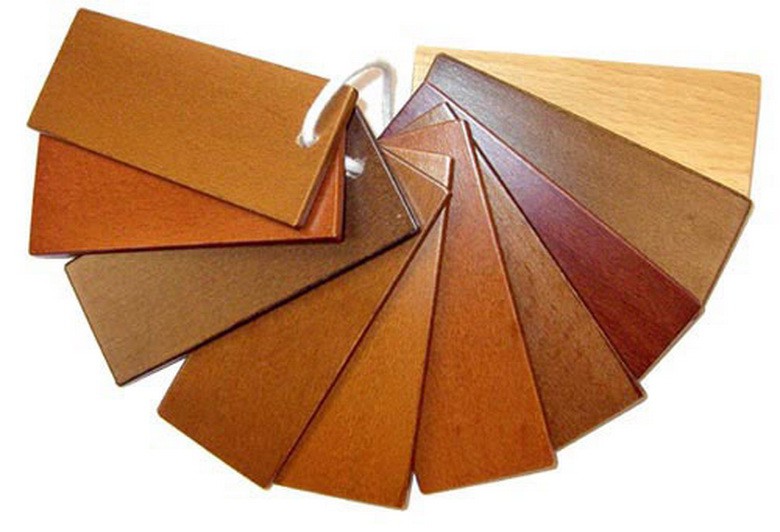
In this question, it is necessary to understand what kind of cover you want to see:
- Creating a dense, opaque coating. These are thick enamels and paints with the basis of liquid acrylic, polyurethane, perchlorvinyl. Also, this group includes rather rare, outdated oil-based formulations.
- Tinting compositions. These are various impregnations that penetrate deeply into the layers of wood, and not only give it a certain shade, but also protecting it from the destructive external influence.
- Transparent coatings. These are a variety of varnishes, both glossy and matte, which cover the surface of the tree with a transparent layer, protecting wood from moisture.
For home use, professional painters recommend applying light in applying compositions, such as:
- Acrylic dyes on water based. They have the most successful consistency for painting with brush, good adhesion and excellent strength ability. Only slightly inferior to oil paints along its surface spreading, which is another plus of these coatings.
- Paints and varnishes on an alkyd basis. They dry quickly, are not affected by temperature fluctuations, and push well liquids, protecting the wooden surface.
ATTENTION: The second option (alkyd paints and varnishes) are best suited for staining bath and kitchen doors.
Due to the high protective properties of these compositions, wood will last much longer, and will continue in best of sight. Besides entrance doorsAlkyd dyes can be painted interior doors in interior.
- Attention should be noted that for better adhesion all paints based on alkyd resin Apply only on a carefully wiped surface. If you do not comply with this condition, the top layer of paint will be covered with bubbles, and over time it will start peeling.
Staining a wooden door produced in several techniques:
- Multiple compositions are used very often. First of all, the door is purified from old paint (see), then covered with primer composition. Sometimes it is necessary to primitive, if the first layer is uneven.
- Then the door leaf is used. If it is possible to remove the door from the loops - it is stained in a vertical state. If the door remains in place, then coloring starts from above. Large smooth panels are covered with a roller (see), small parts are treated with a brush.
- In order for the coating to fit evenly, the layers are dried, and evaluate the result. If necessary, staining repeat so that the paint lay uniformly. It should be avoided too thick layers of raw paint, as they slide down, port appearance Surfaces.
Stages of coloring doors
In addition to the door itself, it is usually necessary to paint the jamb, door butt and loops. In order to evenly cover the paint all the details, the door is better to remove from the loops. After that, paint all the details of the door frame, and dried during the required time.
Door canvas can be cut in paint in two ways:
- Door canvas are removed, and put on the open air, there it is painted. Work on the staining of the internal surfaces of the room must be produced in summer periodSo that there was an opportunity to ventilate.
- Door canvas are not removed, but raise it with the help of wedges, move it from the jamka in such a way that you can get all the elements with a thin tassel.
When the work is over, you don't need to get the wedges, otherwise the inner faces of the door to get in touch with the door butt, the paint is licked.
You can not always remove the door. Sometimes there are structures with fixed loops, handles, door locks. If they cannot be disassembled, then you can neatly glue with paper tape.
Preparation of wooden surface
The wooden surface before painting must be thoroughly prepared. It will take some diligence and accuracy to achieve a good result.

Wood cleaning is made in several stages:
- First stage - complete paint removal. On the surface there should be nothing from the previous coating. In order for the paint easier to remove, the surface is covered with a special composition, which reduces the adhesion between it and the surface of the tree. The residues are removed using a spatula and sandpaper.
- Another way to remove the paint is to use the grinding machine. When used it is necessary to follow all safety rules, and wear a protective mask for the face. Machine paper with large grain is installed on the working surface of the machine.
Heating also allows you to effectively remove the paint. The surface of the door leaf is heated by a construction hairdryer. When bubbles appear, they are opened, and layers remove the paint from the surface to be cleaned.
- The second stage is grinding. This method of processing allows you to remove small scratches, scratch, as well as paint pieces. It is possible in different ways, manually, or emery paper.
- Third stage - putty (see). It is necessary to choose a special composition, for wood, which has a fine-grained structure. If the door is covered with a transparent composition, it is necessary to pick up a putty to the tone of the surface, or paint it with special dyes. When processing, close attention should be paid attention to all minor scratches and surface damage, especially in hard-to-reach places.
- The fourth stage is the finish grinding. It allows you to remove the surface "in zero", ideally aligning it and all the details of the decor if they are present on the surface of the door. It must be remembered that the last grinding is done very delicately, using fine-grained emery paper. After the work of all works, the surface is thoroughly rubbed from dust and working garbage with dry wind.
ATTENTION: If dents are too deep, the usual putty can hold well. It can be replaced by car, without fiberglass.
Old darkened wood array, under a dense layer of paint or varnish, easy to lighten. Chlorine bleach, divorced in water in the proportion of 1: 3.
Color without applying different effects
Purchase of materials directly depends on the number of doors that need to paint. If there are less than two, the sprayer to buy is unprofitable, you can do with an ordinary viper brush.
For large flat canvases without decorative elements It is better to take a roller. The brush before painting it is necessary to fluff well so that poorly fixed hairs can fall out before starting painting.

The door type defines the coloring method:
- The coloring of the panel door will need a little time. It is painted in three receptions. Since she has a flat surface, then a roller is needed. The coating is first applied from all the ends, then they score all the web, starting from the upper left corner, and send the move towards. The next layer is applied at right angles to the first, finishing - as well as at the beginning.
- Doors with a complex surface color only with a brush. Cross all the protruding elements, recesses, wooden threads and patterns, then smooth surfaces for which you can pass the roller.
How to cover the doors of the verse
Before staining the vehicle, the door moisturizes, so the wood increases its adhesion, and the coating is better absorbed and evenly falls.
- All horizontal surfaces are painted by mourn along the fibers, then across, and the last time - again by fiber.
- Jocks, a door frame and a canvas with a transparent veil or lacquer bend begin to bottom, and opaque compositions from top to bottom.
- After the wood processing, the wood-based wood-based wood fibers are straightening, and to align their surface to be aligned with a silent sandpaper. Then the surface is wiped with a dry cloth, and coated with a verse again.
ATTENTION: The surface of the surface after drying is much lighter than the freshly stacked doors. The darker colora can be achieved, repeatedly covering the surface by the mourn.
- To avoid the finish grinding stage, you should choose a veil on an alcohol basis.
Create wood imitation
Almost on any surface you can create imitation of wooden fibers.
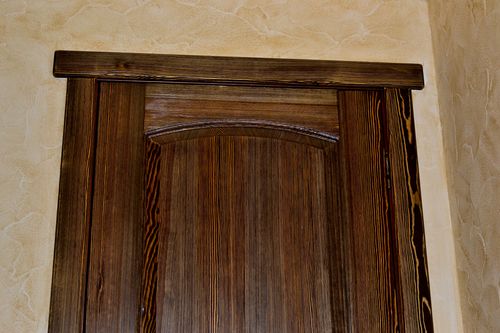
To do this, it is necessary:
- Wood canvas paint with light paint natural shades;
- Then the dried surface is covered with liquid soap with a brush;
- The darker paint is applied on top of the soap, then wash off soap with water.
At home, you can create imitation of a veneer door even on the surface of the plywood door. To implement this method, you will need a special brush sold in construction stores.
- Its metal fibers need to be "combing" the surface of the door leaf, so that visible shallow grooves appear on it.
- The surface is painted with contrast dyes. After drying, patterns characteristic of natural wood appear on the surface.
How to repaint interroom doors you now know. And observing the basic rules, you can learn to paint and decorate any wooden surface. This will not be much difficult.
Restrained on the doors, in the future it will be possible to renovate and more complex interior items - cabinets, tables and servers. Instructions for painting and finishing any kind of doors are on our website.
Interior doors - an important interior element. They not only distinguish between the space and protect the rooms from noise, foreign smells, drafts and dust, but also emphasize their definite style, giving the completeness and transformation of the atmosphere as a whole. Therefore, if interior doors have lost their original look over time, then they must be put in order. Otherwise, even the most gorgeous repair on their background will look unprepacently. And will help in this painting interior doors.

Compared with the complete replacement of the doorway, this event with which you can easily cope with your own hands, is quite inexpensive. Yes, and the result with it can be achieved no worse if you do everything right and give a little to the will of your fantasy. So, how to paint interroom doors, what do you need and what color to choose them? In all this, you will find it in all.
Select the shade for interior door
The interior is ideal when all its elements, including interior doors, are harmoniously chosen to each other. Moreover, in the design there is an important principle - on the color range all the doors should be preferably identical, thanks to which a single holistic picture is created in the house.
But, since it often different rooms are drawn up in separate stylistic and color directions, then at first glance, so immediately find " golden middle»The shade of interior doors is not easy. In these difficult cases, designers are often focused on the color gamut of the main residents of the dwelling:

- hallways;
- halls;
- living rooms.
And when it does not help, the interior doors of all rooms outside (relative to the corridor) can be painted in one color, and from the inside of a separate room - to another. Also, to facilitate the task, designers when choosing the tone of interroom doors, advise paying attention to many parts directly in each room:
- walls;
- ceiling;
- floors;
- plinth;
- furniture;
- decor objects, including textiles.
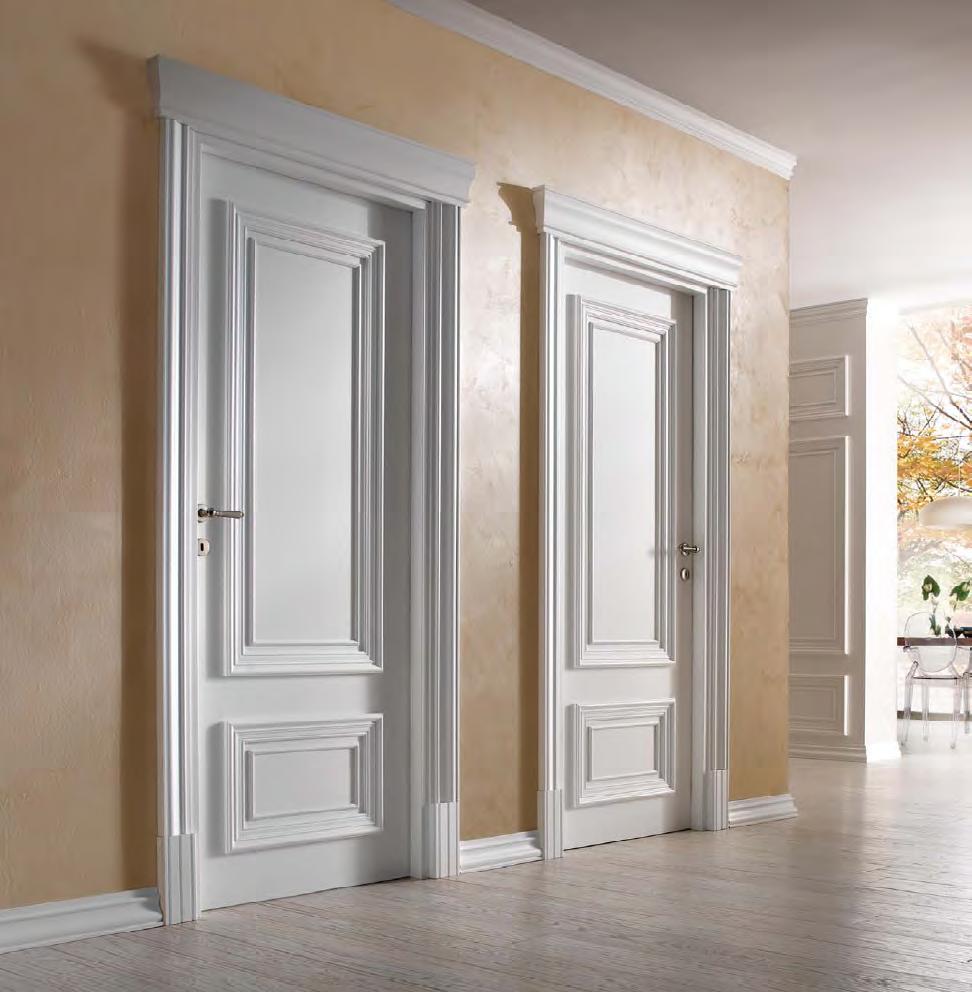
For example, if the floors repeat the color and wood texture, then they can be painted in identical shades. In general, it is believed that natural woody colors are a universal solution for interior doors, as in this case, they fit perfectly in almost any design, perfectly harmony and with floors, and furnished, and with decor objects.
For people who prefer bold solutions and originality, the color of such products can be selected for the design of the walls. In this case, the hue of the doors is better to make a tone above or lower - this will allow you to visually allocate them. As for bright and dark variations, in the first case, interior doors visually expand the premises, creating a laconic lightweight atmosphere in them, and in the second - they will make space more stringent and restrained.

Choosing the type of coloring composition
All colors can be divided into transparent and pigment formulations. The first are varnishes that are more suitable if wooden doors do not have serious defects and they are planned to simply refresh without changing the color. But, since these elements of the interior are functional structures that are in permanent operation, due to this, noticeable chips, cracks and other flares, sprown appearance, often appear on them.
Therefore, often for a high-quality restoration of the door leaf of the elementary coating, lacquer is not enough. To this end, it is advisable to use pigment paints capable of masking and eliminate more serious defects.
In addition to color, paints are different in their composition. The choice of their type according to this parameter will be directly dependent, from which interroom doors are made. By paying attention to the table below, it can be understood in what cases it is better to use one or another type of covering composition.
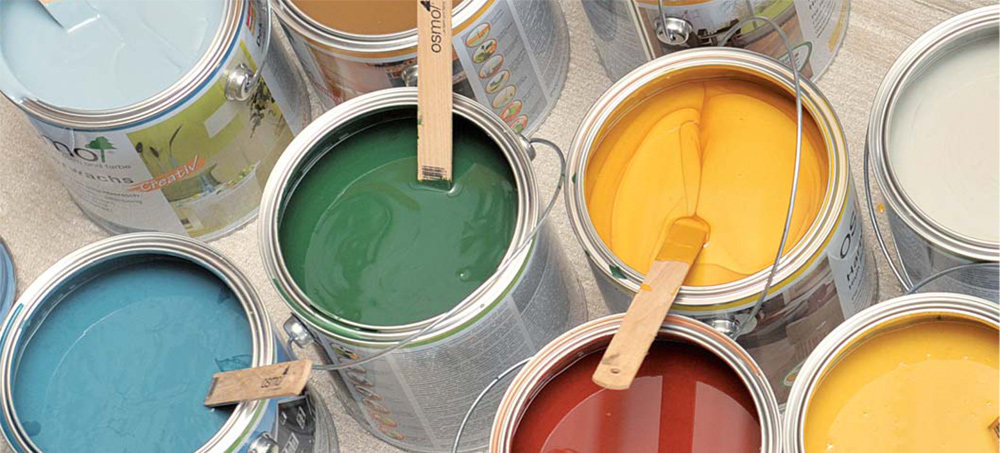
| Material from which the interroom door is made | Recommended paint type |
|---|---|
| Array | Fully wooden products can be painted with practically any paints. For example, all products based on oils and alkyd enamel have proven well and alkyd enamel. These materials have a wide range of colors and after drying form a resistant, durable coating. They have practically no shortcomings, except for a strong smell that felt in the room for 3-4 days after painting the canvas. When the restoration of interroom doors is restored with their own hands in the house where there are children, of course, it is better to use acrylic enamel. It does not smell, non-toxic, dries quickly. But its main drawback is a continuing and short-lived surface. |
| MDF | Doors from MDF It is desirable to paint the compositions in which the tone and varnish (colored varnishes). Such paints help on similar canvases to save the material texture and disguise any existing defects. |
| Veneer | For veneered interior doors, it is extremely recommended to use nitrocracies, since this composite material does not tolerate moisture. After applying such compositions, ugly spots may form. The veneer doors are better painted with polyurethane or glyphthalaic compositions. They do not have a strong smell, so it is comfortable to work with them. As for the choice of color, then according to this parameter, they can be chosen for every taste. |
| According to characteristics | Anticorrosive, moisture resistant, thermal protection, antiseptic. |
| At the place of use | Universal or separate for external and internal works. |
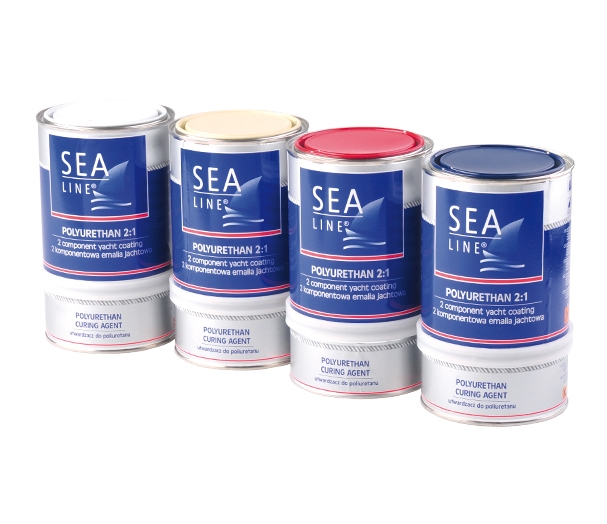
What kind of paint was not selected, in any case, it should be intended for internal works. Moreover, if in the room where the interroom door is located, there is a strong moisture (kitchen, bathroom), the compositions are certainly selected with moisture-resistant qualities.
Staining technology
In addition to the acquisition of paint, the restoration of interroom doors will need to prepare such a tool and an additional building material as:
- ans of medium and shallow grain;
- wood putty;
- solution for removing an old coating (20% technical carbolic acid, caustic potassium or sodium);
- sponge;
- putty knife;
- cotton swabs;
- primer;
- construction Scotch;
- flat brushes of various widths;
- roller;
- paint container;
- stairs;
- screwdriver.
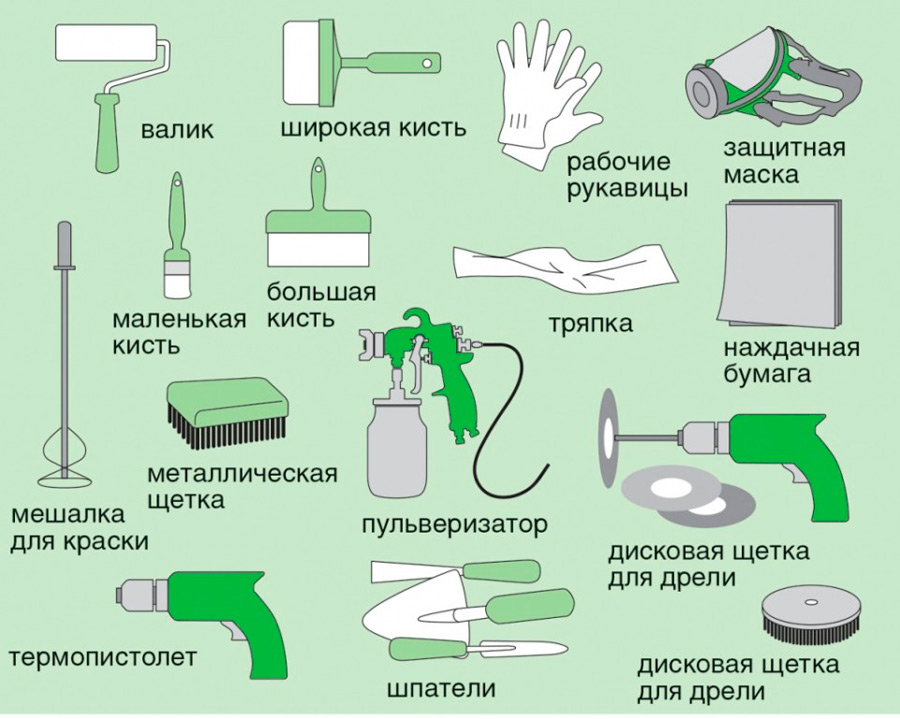
After that, you can proceed to the preparatory work so that the door is suitable for paint. This stage consists of the following steps:
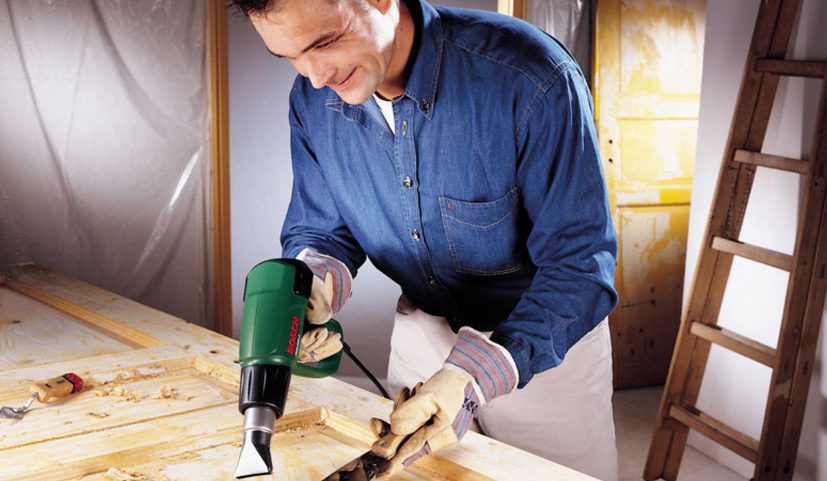
After finishing preparatory work The door canvas must be fully prepared for staining. Directly this process includes the following actions:

Finally, it should be noted that the painting of interior doors should be carried out in rooms with closed windows, where there are no drafts and dust. If everything is done, as described above, the door in the house will look like new ones again. At the same time, their owner will not spend a lot of funds either on masters or paint itself, because the cost of these compositions of any type is now available to everyone.




